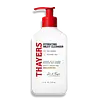What's inside
What's inside
 Key Ingredients
Key Ingredients

 Benefits
Benefits

 Concerns
Concerns

 Ingredients Side-by-side
Ingredients Side-by-side

Water
Skin ConditioningGlycerin
HumectantStearic Acid
CleansingLauric Acid
CleansingPalmitic Acid
EmollientMyristic Acid
CleansingPotassium Hydroxide
BufferingCocamidopropyl Betaine
CleansingBenzyl Glycol
SolventGlyceryl Stearate
EmollientPEG-100 Stearate
Sodium Chloride
MaskingParfum
MaskingPolyquaternium-7
Arachidic Acid
CleansingDisodium EDTA
Ethylhexylglycerin
Skin ConditioningButylene Glycol
HumectantSalicylic Acid
MaskingAllantoin
Skin ConditioningSodium Benzoate
Masking1,2-Hexanediol
Skin ConditioningLavandula Angustifolia Flower Extract
CleansingChamomilla Recutita Flower Extract
MaskingBorago Officinalis Extract
EmollientCentaurea Cyanus Flower Extract
AstringentSalvia Sclarea Extract
AntiseborrhoeicHyacinthus Orientalis Extract
Skin ConditioningCamellia Sinensis Leaf Extract
AntimicrobialWater, Glycerin, Stearic Acid, Lauric Acid, Palmitic Acid, Myristic Acid, Potassium Hydroxide, Cocamidopropyl Betaine, Benzyl Glycol, Glyceryl Stearate, PEG-100 Stearate, Sodium Chloride, Parfum, Polyquaternium-7, Arachidic Acid, Disodium EDTA, Ethylhexylglycerin, Butylene Glycol, Salicylic Acid, Allantoin, Sodium Benzoate, 1,2-Hexanediol, Lavandula Angustifolia Flower Extract, Chamomilla Recutita Flower Extract, Borago Officinalis Extract, Centaurea Cyanus Flower Extract, Salvia Sclarea Extract, Hyacinthus Orientalis Extract, Camellia Sinensis Leaf Extract
Water
Skin ConditioningGlycerin
HumectantCetearyl Alcohol
EmollientSambucus Nigra Flower Water
Skin ConditioningTremella Fuciformis Polysaccharide
Emulsion StabilisingStearyl Alcohol
EmollientPotassium Phosphate
BufferingGlyceryl Stearate
EmollientPEG-40 Stearate
EmulsifyingSodium Hyaluronate
HumectantAmmonium Polyacryloyldimethyl Taurate
Emulsion StabilisingDipotassium Phosphate
BufferingCitric Acid
BufferingTrisodium Ethylenediamine Disuccinate
Ethylhexylglycerin
Skin ConditioningPolysorbate 20
EmulsifyingCetyl Alcohol
EmollientTocopherol
AntioxidantPotassium Sorbate
PreservativeSodium Benzoate
MaskingPhenoxyethanol
PreservativeWater, Glycerin, Cetearyl Alcohol, Sambucus Nigra Flower Water, Tremella Fuciformis Polysaccharide, Stearyl Alcohol, Potassium Phosphate, Glyceryl Stearate, PEG-40 Stearate, Sodium Hyaluronate, Ammonium Polyacryloyldimethyl Taurate, Dipotassium Phosphate, Citric Acid, Trisodium Ethylenediamine Disuccinate, Ethylhexylglycerin, Polysorbate 20, Cetyl Alcohol, Tocopherol, Potassium Sorbate, Sodium Benzoate, Phenoxyethanol
 Reviews
Reviews

Ingredients Explained
These ingredients are found in both products.
Ingredients higher up in an ingredient list are typically present in a larger amount.
Ethylhexylglycerin (we can't pronounce this either) is commonly used as a preservative and skin softener. It is derived from glyceryl.
You might see Ethylhexylglycerin often paired with other preservatives such as phenoxyethanol. Ethylhexylglycerin has been found to increase the effectiveness of these other preservatives.
Glycerin is already naturally found in your skin. It helps moisturize and protect your skin.
A study from 2016 found glycerin to be more effective as a humectant than AHAs and hyaluronic acid.
As a humectant, it helps the skin stay hydrated by pulling moisture to your skin. The low molecular weight of glycerin allows it to pull moisture into the deeper layers of your skin.
Hydrated skin improves your skin barrier; Your skin barrier helps protect against irritants and bacteria.
Glycerin has also been found to have antimicrobial and antiviral properties. Due to these properties, glycerin is often used in wound and burn treatments.
In cosmetics, glycerin is usually derived from plants such as soybean or palm. However, it can also be sourced from animals, such as tallow or animal fat.
This ingredient is organic, colorless, odorless, and non-toxic.
Glycerin is the name for this ingredient in American English. British English uses Glycerol/Glycerine.
Learn more about GlycerinGlyceryl Stearate is a mix of glycerin and stearic acid.
It is used to stabilize the mixing of water and oil ingredients. By preventing these ingredients from separating, it can help elongate shelf life. It can also help thicken the product's texture.
As an emollient, it helps soften skin and supports barrier-replenishing ingredients.
In cosmetics, Glyceryl Stearate is often made from vegetable oils or synthetically produced.
This ingredient may not be fungal-acne safe
Fun fact: The human body also creates Glyceryl Stearate naturally.
Learn more about Glyceryl StearateSodium Benzoate is a preservative. It's used in both cosmetic and food products to inhibit the growth of mold and bacteria. It is typically produced synthetically.
Both the US FDA and EU Health Committee have approved the use of sodium benzoate. In the US, levels of 0.1% (of the total product) are allowed.
Sodium benzoate works as a preservative by inhibiting the growth of bacteria inside of cells. It prevents the cell from fermenting a type of sugar using an enzyme called phosphofructokinase.
It is the salt of benzoic acid. Foods containing sodium benzoate include soda, salad dressings, condiments, fruit juices, wines, and snack foods.
Studies for using ascorbic acid and sodium benzoate in cosmetics are lacking, especially in skincare routines with multiple steps.
We always recommend speaking with a professional, such as a dermatologist, if you have any concerns.
Learn more about Sodium BenzoateWater. It's the most common cosmetic ingredient of all. You'll usually see it at the top of ingredient lists, meaning that it makes up the largest part of the product.
So why is it so popular? Water most often acts as a solvent - this means that it helps dissolve other ingredients into the formulation.
You'll also recognize water as that liquid we all need to stay alive. If you see this, drink a glass of water. Stay hydrated!
Learn more about Water